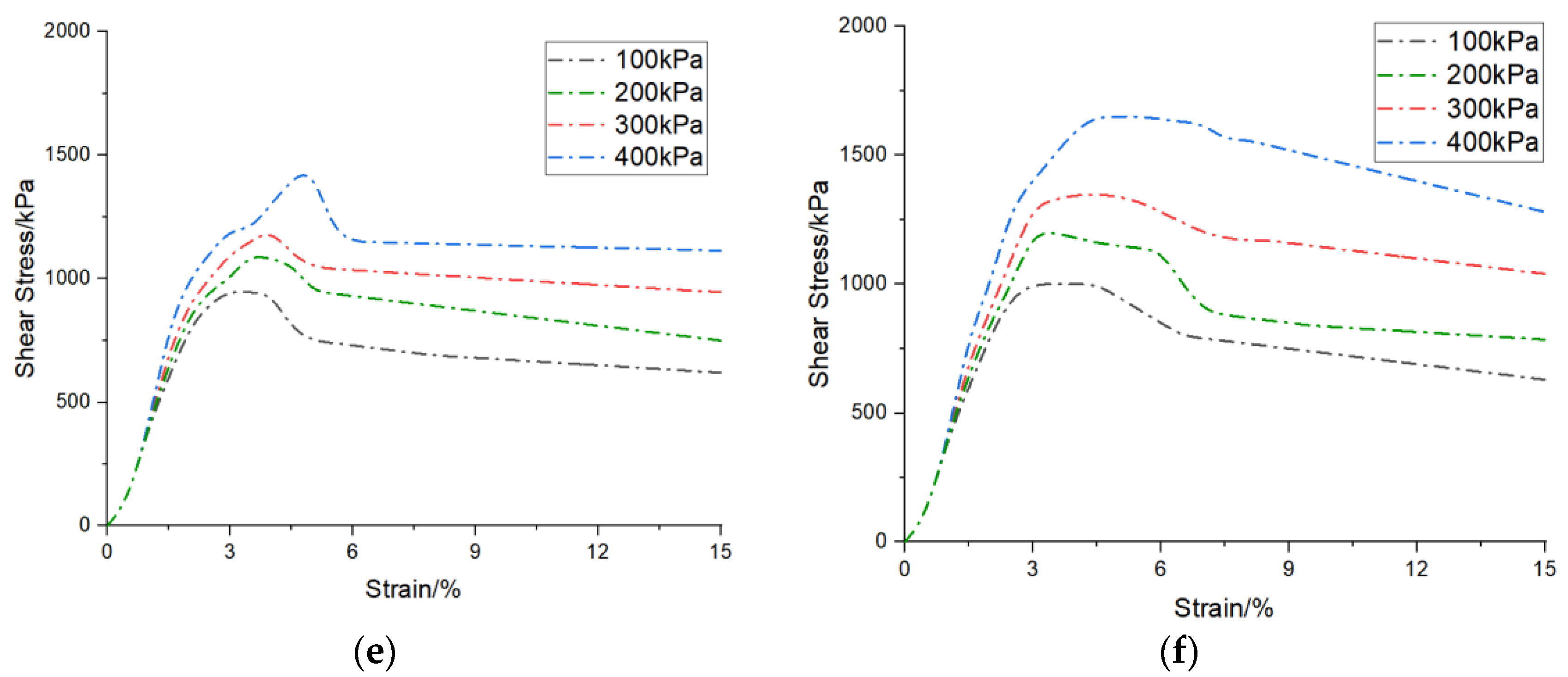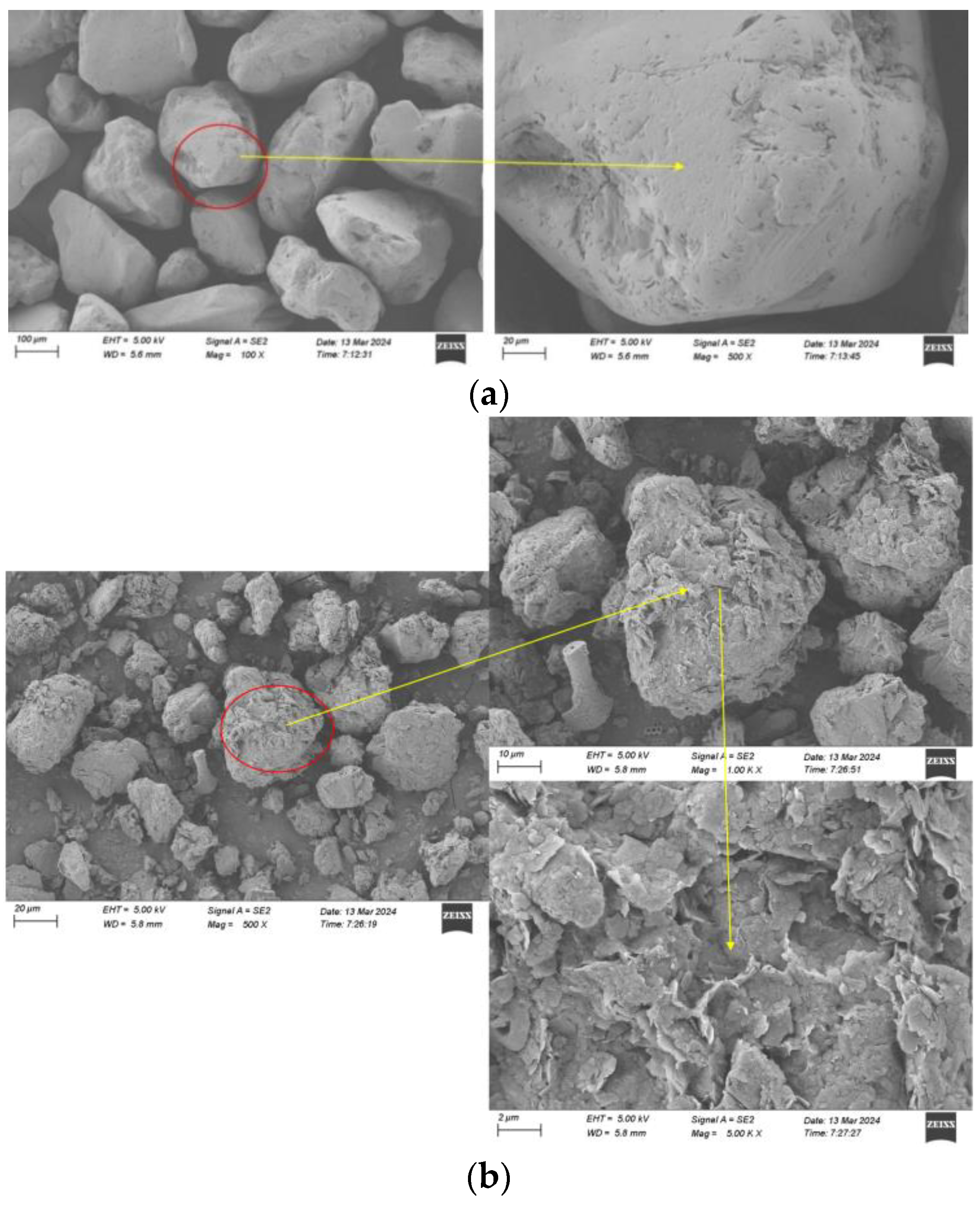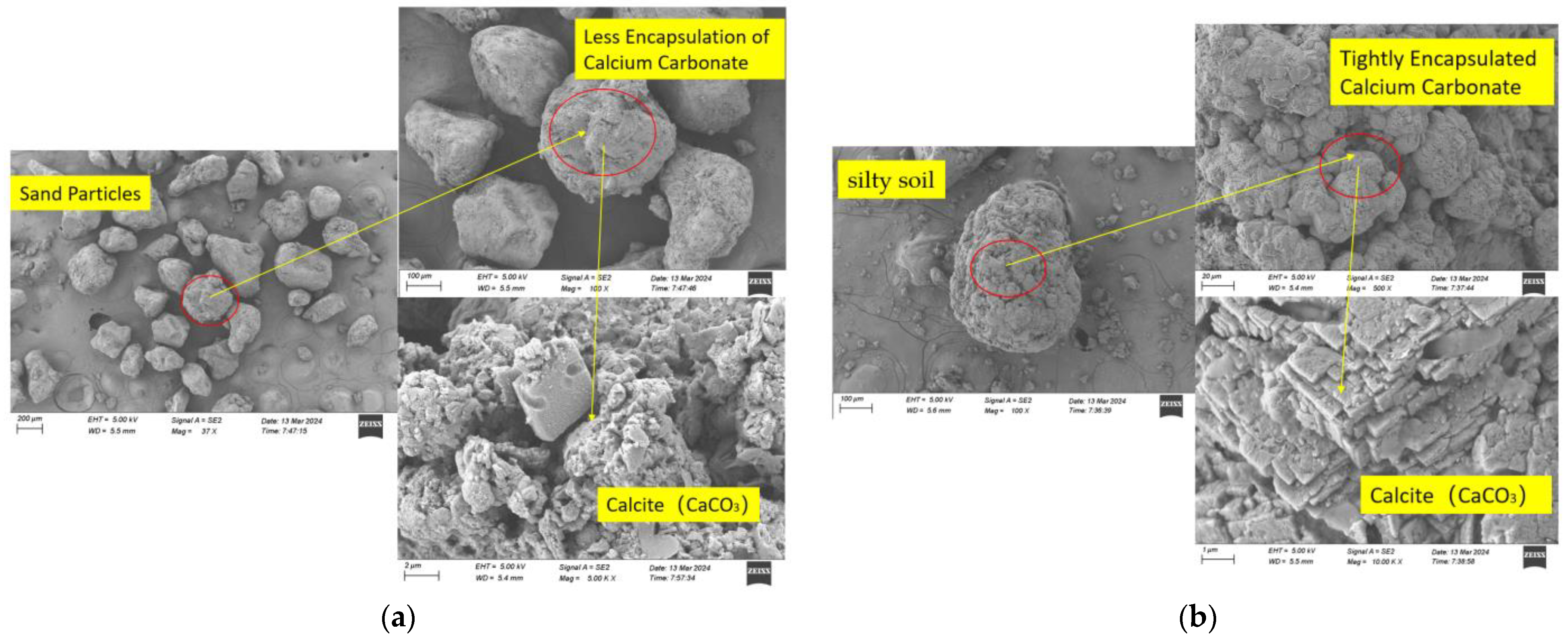Experimental Study on Enhancing the Mechanical Properties of Sandy Soil by Combining Microbial Mineralization Technology with Silty Soil
Abstract
:1. Introduction
2. Experimental Materials and Methods
2.1. Test Materials
2.2. Test Broths and Media
2.3. Sample Preparation
2.4. Curing Process
2.5. Calcium Carbonate Generation Rate
2.6. Triaxial Shear Test
- (1)
- Before conducting the test, check for any damage to the rubber membrane, ensure the smoothness of all inlet and outlet pipelines, and purge any air bubbles in the pore water pressure system;
- (2)
- Use a membrane carrier to wrap the rubber membrane around the sample. Use an ear syringe to remove excess air inside the rubber membrane. Place the prepared sample into the membrane carrier;
- (3)
- Place pervious stones at the bottom of the pressure chamber, then place the sample on top of the pervious stones. Remove the support cylinder and place pervious stones and the sleeve on top of the sample. Securely tie the ends of the rubber membrane and install the pressure-type outer casing;
- (4)
- After tightening the outer-casing screws, open the inlet valve and fill the pressure chamber with water. Close the inlet valve after the pressure chamber is filled with water, apply the designed confining pressure, and load at a rate of 1 mm/min;
- (5)
- Stop the test when the axial strain reaches 15%. Take the difference in the principal stresses at 15% axial strain as the failure point and calculate the UU test strength parameters based on the Mohr–Coulomb criterion. Afterward, unload the confining pressure, remove the outer-casing pressure, and record the data, such as the shear stress–strain.
2.7. SEM Curing Mechanism Analysis
3. Results and Discussion
3.1. Calcium Carbonate Generation Rate Test
3.2. Unconsolidated and Undrained Triaxial Shear Test
3.2.1. Mechanical-Strength Properties
3.2.2. Shear Strength Index Analysis
3.3. SEM Solidification Mechanism Analysis
4. Conclusions
- (1)
- Compared with the pure-sand specimens, the calcium carbonate generation rates increased from 15.31% to 18.93% with the addition of 1–5% silty clay, indicating that the addition of silty clay during the experiment increased the calcium carbonate generation rates of the specimens. The cementitious material increased with the increase in the amount of silty clay added, reaching the optimum dosage at 5%;
- (2)
- The shear strength curve shows the strain-softening phenomenon. As the content of silty clay increased from 1% to 5%, the peak deviator stress increased by 4.2–43.2%, indicating that the addition of silty clay enhanced the shear strength of the specimens. The strength index cohesion and internal-friction angles were further verified through the shear strength envelope curves;
- (3)
- SEM experiments showed that the strengthening mechanism of the silty clay on the MICP-solidified sandy soil mainly included the physical-filling and adsorption effects of the particles. After adding silty clay, the overall pore structure of the specimens was optimized, the calcium carbonate generation rate increased, and the cohesion between the particles became stronger, thereby improving the overall strength of the specimens;
- (4)
- In addition, future research could consider simultaneously adding silty clay and fibers to sandy soil to explore whether both the strength and stiffness can be improved. Moreover, future studies could consider changing the concentration of the cementing solution to observe whether lower concentrations can enhance the mechanical strength of MICP specimens with added silty clay.
Author Contributions
Funding
Institutional Review Board Statement
Informed Consent Statement
Data Availability Statement
Conflicts of Interest
References
- Li, B.; Qi, H.F. Exploration of the main geotechnical engineering problems in the construction of Haikou Jiangdong New District Project. Shanxi Archit. 2020, 46, 72–74. [Google Scholar]
- Zhang, X. Foundation Treatment Technology Development and Prospects. China Constr. 2019, 8, 162–163. [Google Scholar]
- Jha, A.H. Microbiological Processes in Improving the Behavior of Soils for Civil Engineering Applications: A Critical Appraisal. J. Hazard. Toxic Radioact. Waste 2022, 26, 03122001. [Google Scholar] [CrossRef]
- Suriya, P.; Sangeetha, S.P. Sustainable Ground Improvement Through Microbial Induced Calcium Precipitation—A Review. J. Environ. Account. Manag. 2022, 10, 143–155. [Google Scholar] [CrossRef]
- Keykha, H.A.; Zangani, A.; Romiani, H.M.; Asadi, A.; Kawasaki, S.; Radmanesh, N. Characterizing Microbial and CO2-Induced Carbonate Minerals: Implications for Soil Stabilization in Sandy Environments. Minerals 2023, 13, 976. [Google Scholar] [CrossRef]
- Aliyu, A.D.; Mustafa, M.; Aziz, N.A.A.; Hadi, N.S. A Study on Bio-Stabilisation of Sub-Standard Soil by Indigenous Soil Urease-Producing Bacteria. Pertanika J. Sci. Technol. 2023, 31, 2389–2412. [Google Scholar] [CrossRef]
- Sharma, M.; Satyam, N.; Reddy, K.R. Rock-like behavior of biocemented sand treated under non-sterile environment and various treatment conditions. J. Rock Mech. Geotech. Eng. 2021, 13, 705–716. [Google Scholar] [CrossRef]
- E Portugal, C.R.M.; Fonyo, C.; Machado, C.C.; Meganck, R.; Jarvis, T. Microbiologically Induced Calcite Precipitation biocementation, green alternative for roads—is this the breakthrough? A critical review. J. Clean. Prod. 2020, 262, 121372. [Google Scholar] [CrossRef]
- Lin, H.; Suleiman, M.T.; Brown, D.G. Investigation of pore-scale CaCO3 distributions and their effects on stiffness and permeability of sands treated by microbially induced carbonate precipitation (MICP). Soils Found. 2020, 60, 944–961. [Google Scholar] [CrossRef]
- Liu, X.; Gao, X.; Pan, C. Experimental study on shear strength of cracks in Micp solidified soil sites. China Civ. Eng. J. 2022, 55, 88–94. [Google Scholar]
- Liu, S.; Yu, J.; Zeng, W.; Peng, X.; Cai, Y.; Tu, B. Study on the effect of microbial induced calcium carbonate precipitation on repairing cracks in composite soil. Chin. J. Rock Mech. Eng. 2020, 39, 191–204. [Google Scholar]
- Kumari, D.; Pan, X.; Lee, D.J.; Achal, V. Immobilization of cadmium in soil by microbially induced carbonate precipitation with Exiguobacterium undae at low temperature. Int.Biodeterior. Biodegrad. 2014, 94, 98–102. [Google Scholar] [CrossRef]
- Kang, C.H.; Han, S.H.; Shin, Y.J.; Oh, S.J.; So, J.S. Bioremediation of Cd by Microbially Induced Calcite Precipitation. Appl. Biochem. Biotechnol. 2014, 172, 2907–2915. [Google Scholar] [CrossRef]
- Suriya, P.; Sangeetha, S.P. Increasing the Strength Properties in Weak Soil Using Microbial Techniques. J. Environ. Account. Manag. 2021, 9, 377–389. [Google Scholar] [CrossRef]
- Li, Y. Experimental Study on MlCP Reinforcement of Sandy Slope Soil; Zhejiang University: Hangzhou, China, 2022. [Google Scholar]
- Fronczyk, J.; Marchelina, N.; Pyzik, A.; Franus, M. Assessment of the Composition Effect of a Bio-Cementation Solution on the Efficiency of Microbially Induced Calcite Precipitation Processes in Loose Sandy Soil. Materials 2023, 16, 5767. [Google Scholar] [CrossRef]
- Dejong, J.T.; Mortensen, B.M.; Martinze, B.C. Bio-mediated soil improvement. Ecol. Eng. 2010, 36, 197–210. [Google Scholar] [CrossRef]
- Van, P.L.A.; Ghose, R.; Linden, T.J.M. Quantifying Biomediated Ground Improvement by Ureolysis: Large-Scale Biogrout Experiment. J. Geotech. Geoenviron. Eng. 2010, 136, 1721–1728. [Google Scholar]
- Van, P.L.A.; Daza, C.M.; Staal, M. Potential soil reinforcement by biological denitrification. Ecol. Eng. 2009, 36, 168–175. [Google Scholar]
- Fan, S.S. A Preliminary Study on New Technology of Microbial Denitrification Soil Reinforcement; Huazhong University of Science and Technology: Wuhan, China, 2013. [Google Scholar]
- Warthmann, R.; Van, L.Y.; Vasconcelos, C. Bacterially induced dolomite precipitation in anoxic culture experiments. Geology 2000, 28, 1091–1094. [Google Scholar] [CrossRef]
- Weaver, T.; Burbank, M.; Lewis, R. Bio-Induced Calcite, Iron, and Manganese Precipitation for Geotechnical Engineering Applications. In Proceedings of the Geo-Frontiers 2011: Advances in Geotechnical Engineering, Dallas, TX, USA, 13–16 March 2011; pp. 3975–3983. [Google Scholar]
- Chu, J.; Ivanov, V. Iron-and calcium-based biogrouts for soil improvement. In Proceedings of the Geo-Congress 2014, Atlanta, GA, USA, 23–26 February 2014; pp. 1596–1601. [Google Scholar]
- Zúñiga-Barra, H.; Ostojic, C.; Torres-Aravena, Å.; Rivas, M.; Vílchez, C.; Jeison, D. Use of photosynthetic MICP to induce calcium carbonate precipitation: Prospecting the role of the microorganism in the formation of CaCO3 crystals. Algal Res. 2024, 80, 103499. [Google Scholar] [CrossRef]
- Ahmad, M.A.; Zhang, J.; Liu, B.; Guohao, X.; Xiaoyi, T.; Haoying, G.; Changjie, S.; Runhao, L.; Xiaona, X.; Weilin, L.; et al. Synergistic effect of composite bacteria on self-healing process of concrete crack. Case Stud. Constr. Mater. 2024, 20, e03028. [Google Scholar] [CrossRef]
- Kumar, K.; Naskar, J.; Sharma, A.K. Effectiveness of microbial induced calcite precipitation on sand-clay mixtures. In Proceedings of the Geo-Congress 2023, Los Angeles, CA, USA, 26–29 March 2023; pp. 340–350. [Google Scholar]
- Ramachandran, A.L.; Ghalib, M.; Dhami, N.K.; Cheema, D.; Mukherjee, A. Multi-functional performance of biopolymers and biocement in stabilisation of road bases. Constr. Mater. 2024, 177, 29–43. [Google Scholar] [CrossRef]
- Nikseresht, F.; Landi, A.; Sayyad, G.; Ghezelbash, G.; Schulin, R. Sugarecane molasse and vinasse added as microbial growth substrates increase calcium carbonate content, surface stability and resistance against wind erosion of desert soils. J. Environ. Manag. 2020, 268, 110639. [Google Scholar] [CrossRef] [PubMed]
- Zhao, Y.; Fan, C.; Liu, P. Effect of activated carbon on microbial-induced calcium carbonate precipitation of sand. Environ. Earth Sci. 2018, 77, 615. [Google Scholar] [CrossRef]
- Xie, Y.H.; Tang, C.S.; Yin, L.Y. Mechanical behavior of microbial-induced calcite precipitation (MICP)-treated soil with fiber reinforcement. Chin. J. Geotech. Eng. 2019, 41, 675–682. [Google Scholar]
- Zheng, J.J.; Song, Y.; Wu, C.C. Experimental study on mechanical properties of basalt fiber reinforced MICP-treated sand. J. Huazhong Univ. Sci. Technol. (Nat. Sci. Ed.) 2019, 47, 73–78. [Google Scholar]
- Xiao, Y.; He, X.; Evans, T.M. Unconfined compressive and splitting tensile strength of basalt fiber-reinforced biocemented sand. J. Geotech. Geoenviron. Eng. 2019, 145, 04019048. [Google Scholar] [CrossRef]
- Zhang, G.C.; Tong, H.W.; Peng, Q.W. The effect of magnesium on the experiment of microbial reinforcement of sand. Sci. Technol. Eng. 2020, 20, 10659–10664. [Google Scholar]
- Ma, R.N.; Guo, H.X.; Chen, X.H. Influence of magnesium ion on the strength of microbial mortar. Ind. Build. 2018, 48, 121–125. [Google Scholar]
- Zhi, Y.Y. MICP Experiment and Mechanism Research on Reinforcement of Fractured Rock Mass; China Three Gorges University: Yichang, China, 2020. [Google Scholar]
- Vasić, M.V.; Pezo, L.; Radojević, Z.; Stankovic, S.M. Serbian heavy clays behavior: Application in rough ceramics. Hem. Ind. 2013, 67, 811–822. [Google Scholar]
- Vasić, M.V.; Mijatović, N.; Radojević, Z. Aplitic Granite Waste as Raw Material for the Production of Outdoor Ceramic Floor Tiles. Materials 2022, 15, 3145. [Google Scholar] [CrossRef] [PubMed]
- Hu, J.; Yang, Y.; Zhou, Y.; Xiang, H.; Wei, K. Experimental Study of MICP-Solidified Calcareous Sand Based on Ambient Temperature Variation in the South China Sea. Sustainability 2023, 15, 8245. [Google Scholar] [CrossRef]
- Xiao, Y.; Liu, H.L.; Nan, B. Gradation-Dependent Thermal Conductivity of Sands. J. Geotech. Geoenviron. Eng. 2018, 144, 06018010. [Google Scholar] [CrossRef]
- Choi, S.-G.; Park, S.-S.; Wu, S.; Chu, J. Methods for Calcium Carbonate Content Measurement of Biocemented Soils Choi. J. Mater. Civ. Eng. 2017, 29, 06017015. [Google Scholar] [CrossRef]
- Chen, G.; Lv, Y.; Huang, Z.; Chang, Y. Study on Shear Strength Experiments Base on the Modified Direct Shear Apparatus for Unsaturated Soils. Appl. Mech. Mater. 2013, 438–439, 1176–1180. [Google Scholar] [CrossRef]
- Lai, Y.; Liu, S.; Cai, Y.; Yu, J. Reinforcement of Different Sands by Low-pH Bio-Mineralization. Materials 2023, 16, 6211. [Google Scholar] [CrossRef] [PubMed]
- Lai, H.; Cui, M.; Chu, J. Effect of pH on soil improvement using one-phase-low-pH MICP or EICP biocementation method. Acta Geotech. 2023, 18, 3259–3272. [Google Scholar] [CrossRef]
- Zhao, Y.; Li, Y.; Bi, J.; Wang, C.; Li, Y.; Zhong, X. Triaxial compression experiment and damage constitutive model of microbially modified strongly weathered phyllite. Constr. Build. Mater. 2023, 393, 131962. [Google Scholar] [CrossRef]
- Zheng, W. Study on Shear Properties ofBasalt Fiber-EICP Modified Silt. Master’s Thesis, Henan University, Kaifeng, China, 2022. [Google Scholar]
















| Yeast Culture Medium | Weight | Unit | Brand |
|---|---|---|---|
| Yeast extract | 20 | g | OXOID |
| NH4Cl | 10 | g | Shanghai Pharmaceutical Trial |
| NiCl2 | 24 | mg | Damao |
| MnSO4 | 10 | mg | Shanghai Pharmaceutical Trial |
| H2O | 1 | L | / |
| NaOH | 1 | mol/L | XNK |
Disclaimer/Publisher’s Note: The statements, opinions and data contained in all publications are solely those of the individual author(s) and contributor(s) and not of MDPI and/or the editor(s). MDPI and/or the editor(s) disclaim responsibility for any injury to people or property resulting from any ideas, methods, instructions or products referred to in the content. |
© 2024 by the authors. Licensee MDPI, Basel, Switzerland. This article is an open access article distributed under the terms and conditions of the Creative Commons Attribution (CC BY) license (https://creativecommons.org/licenses/by/4.0/).
Share and Cite
Hu, J.; Fan, F.; Huang, L.; Yu, J. Experimental Study on Enhancing the Mechanical Properties of Sandy Soil by Combining Microbial Mineralization Technology with Silty Soil. Materials 2024, 17, 2362. https://doi.org/10.3390/ma17102362
Hu J, Fan F, Huang L, Yu J. Experimental Study on Enhancing the Mechanical Properties of Sandy Soil by Combining Microbial Mineralization Technology with Silty Soil. Materials. 2024; 17(10):2362. https://doi.org/10.3390/ma17102362
Chicago/Turabian StyleHu, Jun, Fei Fan, Luyan Huang, and Junchao Yu. 2024. "Experimental Study on Enhancing the Mechanical Properties of Sandy Soil by Combining Microbial Mineralization Technology with Silty Soil" Materials 17, no. 10: 2362. https://doi.org/10.3390/ma17102362






